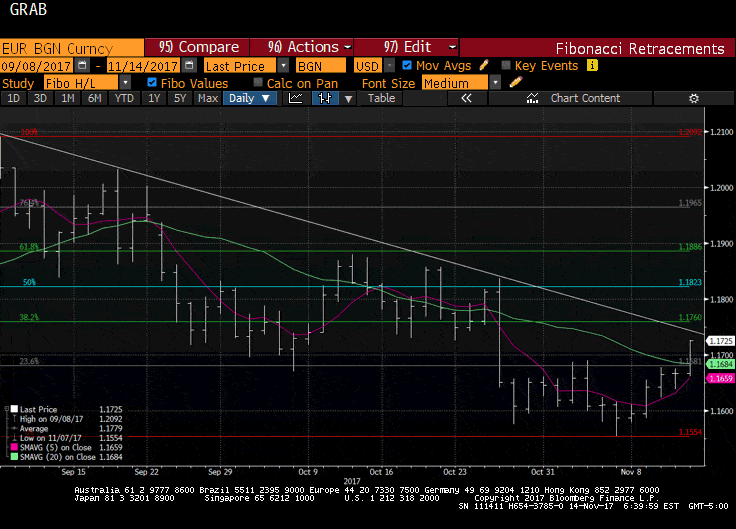This Great Graphic, created on Bloomberg, shows that the euro is approaching key area.
The white trendline drawn off the September 8, September 20 and October 26 highs comes in near $1.1745 today. Above there, the lower green horizontal line is the 38.2% retracement of the drop since the years high was recorded on September 8. It is found at $1.1760.
The euro has been bid through the 20-day moving average (green line) for the first time since the ECB meeting in late October. The five-day moving average (fuchsia line) is poised to cross above the 20-day average for the first time since before the ECB meeting.
The 100-day moving average, which is not shown in the chart, comes in today a little above $1.1730. The euro fell below it with the ECB-inspired sell-off at the end of last month for the first time since April. It checked the euro earlier this month. A move above this general area would target the $1.1825-$1.1885 area. The technical indicators on the daily charts warn of this upside risk.
There is much talk about a seasonal pattern for euro weakness in Q4, but we are skeptical. The euro did fall in October this year and the past three years. It also fell on November 2014-2016. In December, the euro has fallen in two of the past three years. If one flipped a coin six times and four times it came up heads, one would not think the contest is rigged, but some market participant sees a seasonal pattern here. We argue that the sample size is too small and when it is enlarged to cover the past 20 years, no such seasonality is evident. Over the past 20 years, the euro has risen in exactly 10 of the Octobers. It has risen in nine of the past 20 Novembers and Decembers. If there is a pattern it might be that the euro’s performance in Q4 is consistent with its underlying trend. Recall that the euro put in the recent peak in 2014, when the seasonal pattern is said to have begun.
Technical indicators of the daily bar charts suggest upside room, while the two-year interest rate differential makes it the most expensive to hold long euros against the dollar since the last 1990s. We continue to argue that divergence of monetary policy (rates and balance sheet) is still more than a year away from peaking. We are inclined to view the euro gains as corrective after retreating for the past two months.
Opinions expressed are solely of the author’s, based on current market conditions, and are subject to change without notice. These opinions are not intended to predict or guarantee the future performance of any currencies or markets. This material is for informational purposes only and should not be construed as research or as investment, legal or tax advice, nor should it be considered information sufficient upon which to base an investment decision. Further, this communication should not be deemed as a recommendation to invest or not to invest in any country or to undertake any specific position or transaction in any currency. There are risks associated with foreign currency investing, including but not limited to the use of leverage, which may accelerate the velocity of potential losses. Foreign currencies are subject to rapid price fluctuations due to adverse political, social and economic developments. These risks are greater for currencies in emerging markets than for those in more developed countries. Foreign currency transactions may not be suitable for all investors, depending on their financial sophistication and investment objectives. You should seek the services of an appropriate professional in connection with such matters. The information contained herein has been obtained from sources believed to be reliable, but is not necessarily complete in its accuracy and cannot be guaranteed.
Recommended Content
Editors’ Picks
EUR/USD holds below 1.0750 ahead of key US data

EUR/USD trades in a tight range below 1.0750 in the European session on Friday. The US Dollar struggles to gather strength ahead of key PCE Price Index data, the Fed's preferred gauge of inflation, and helps the pair hold its ground.
USD/JPY stays firm above 156.00 after BoJ Governor Ueda's comments

USD/JPY stays firm above 156.00 after surging above this level on the Bank of Japan's decision to leave the policy settings unchanged. BoJ Governor said weak Yen was not impacting prices but added that they will watch FX developments closely.
Gold price oscillates in a range as the focus remains glued to the US PCE Price Index

Gold price struggles to attract any meaningful buyers amid the emergence of fresh USD buying. Bets that the Fed will keep rates higher for longer amid sticky inflation help revive the USD demand.
Bitcoin Weekly Forecast: BTC’s next breakout could propel it to $80,000 Premium

Bitcoin’s recent price consolidation could be nearing its end as technical indicators and on-chain metrics suggest a potential upward breakout. However, this move would not be straightforward and could punish impatient investors.
US core PCE inflation set to signal firm price pressures as markets delay Federal Reserve rate cut bets

The core PCE Price Index, which excludes volatile food and energy prices, is seen as the more influential measure of inflation in terms of Fed positioning. The index is forecast to rise 0.3% on a monthly basis in March, matching February’s increase.
